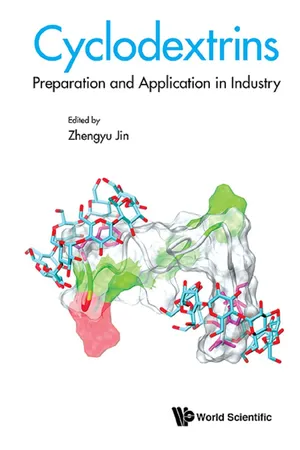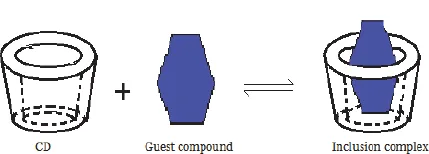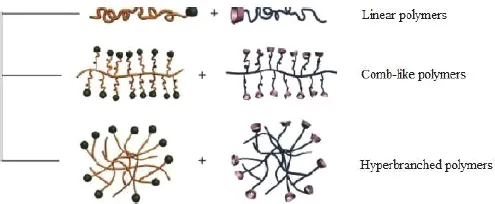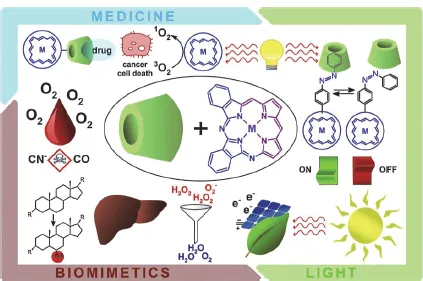![]()
1.Introduction
Junrong Huang, Qi Yang, and Huayin Pu
Shaanxi University of Science and Technology,
Weiyang District, Xi’an, Shaanxi 710021, China
1.1Introduction
Cyclodextrins (CDs) are cyclic, nonreducing oligosaccharides linked through α-1,4 glycosidic bonds. Due to steric repulsion, CDs have more than six glucose units. α-, β-, and γ-CDs contain six, seven, and eight glucose units, respectively. The chair conformation of glucopyranose units results in CD molecules having a truncated cone shape, with a somewhat hydrophobic central cavity and a hydrophilic outer surface [1]. This structure enables them to interact with poorly water-soluble compounds, thereby solubilizing them via the formation of host–guest inclusion complexes [2]. Normally, the hydrophobic chains of amphiphiles are included in host–guest complexes with 1:1 or 2:1 stoichiometry with high binding constants. In the late 1960s, the appearance of polyether and realization of its recognition capacity created the concept of host–guest chemistry. CDs possess excellent properties in terms of molecular recognition, molecular interaction, and molecular aggregation, and many molecules of a suitable size can undergo inclusion complexation with CDs. The wide availability and low cost of CDs facilitates their use in various fields including analysis, catalysis, and surface chemistry, and in many industries such as pharmaceuticals, cosmetics, textiles, and food [3].
In recent times, supramolecular chemistry has attracted considerable attention as an important subdiscipline of chemistry that develops molecular building blocks for the construction of novel systems with intriguing properties that differ from their separate components [4]. CDs are generally composed of both hydrophilic and hydrophobic moieties. Through hydrophobic and other noncovalent interactions, CD molecules can form various self-assembled structures in aqueous solutions including micelles, vesicles, lyotropic liquid crystals, and gels, all of which have found many applications in the fields of cosmetics, drug delivery, materials synthesis, and microreactors. A great deal of attention has been given to the construction of novel ordered and functional assemblies due to their delicate and highly organized aggregate structures. Different approaches have been developed including molecular structure modification to tune the amphiphile hydrophilic/hydrophobic balance and introduce molecular motifs such as host molecules to form inclusion complexes, and CDs are now considered effective modulators of the self-assembly of amphiphiles [5].
Host–guest interactions of CDs are derived from many aspects including hydrophobic interactions, Van der Waals interactions, the ring tension of the CD, the surface tension of the solvent, and the effect of hydrogen bonds. Numerous guest molecules of an appropriate size are generally able to form inclusion complexes with CDs (Fig. 1.1) [6, 7].
Polymeric systems based on CDs and certain guest molecules have been developed in recent years. For example, the application of nanoparticle and micelle macromolecular materials has attracted widespread attention in medical and biological fields, especially for continuous drug release, targeted delivery, and tissue engineering. Many stimuli-responsive polymeric networks with novel structures have been designed through chemical cross-linking, physical aggregation, and other means [3]. Polymeric systems based on CDs and guest molecule inclusion complexes can vary in structure and may be linear, branched, comb-like, or hyperbranched, as shown in Fig. 1.2. These structures can subsequently form higher-order structures such as peels, micelles, vesicles, and tubes, which can be used in many ways.
Fig. 1.1. Schematic representation of inclusion complex formation (1:1) between a CD and a guest molecule [6].
Fig. 1.2. Schematic illustration of polymeric systems based on CDs and guest molecule inclusion complexes [3].
Supramolecular systems often resemble naturally occurring molecules in structure and function; hence they are considered biomimetics. Key life processes including photosynthesis and oxygen storage are dependent on complex formation via supramolecular building molecules such as porphyrinoids (Fig. 1.3) [4].
1.2Applications in foods
1.2.1Applications in controlled flavor release
Flavor plays an important role in consumer satisfaction and influences the consumption of foods. Manufacturing and storage processes, packaging materials and ingredients in foods often modify the overall flavor by reducing aroma compound intensity or generating off-flavor components [8]. To limit aroma degradation or loss during processing and storage, it is beneficial to encapsulate volatile ingredients prior to use in foods, especially in beverages [8, 9]. The addition of β-CD as a stabilizing or thickening agent can help to retain some aroma compounds in food matrices during cooking, pasteurization, and other thermal processes [10].
Fig. 1.3. Various functionalities of cyclodextrin-porphyrinoid systems [4].
1.2.2Applications in special-flavor correction
Some special flavors in foods are unpopular. Although a degree of bitterness is expected in beverages such as coffee, beer, and wine, a bitter taste is the main reason for the rejection of various food products. The degree of bitterness has proved a major limitation in the acceptance of commercial citrus juices. Two classes of chemical compounds, flavonoids (mainly naringin), and limonoids (mainly limonin) are largely responsible and have notable differences. A commercial process is therefore needed that removes bitter components without adding or changing food products, while maintaining the unique and expected flavor and the nutritional value of the products [9].
To suppress unpleasant odors or tastes, CDs can be used to remove or mask undesirable components. Some foods have a peculiar smell, but when CDs are added during manufacturing, these components can form CD inclusion complexes, deodorizing the resulting products. With the aim of masking the bitter taste using CDs, Binello and colleagues prepared a series of macromolecular derivatives in which β-CD and γ-CD were covalently bound to carboxy methyl chitosan (CM-chitosan) and carboxymethyl cellulose (CM-cellulose), which worked successfully on limonin, naringin, and caffeine [11].
1.2.3Applications in protecting food ingredients
The formation of inclusion complexes with CDs can protect some food components that are sensitive to degradation by oxygen, heat, or light. In the production of juices, the mechanical damage suffered by vegetable and fruit tissues often leads to rapid enzyme-catalyzed browning reactions. Polyphenoloxidase converts colorless polyphenols into colored compounds, and fruit and vegetable juices can be treated with CDs to remove this enzyme by complexation [12].
1.3Applications in environmental protection
1.3.1Applications in wastewater treatment
Water availability has become a major problem in most regions of the world due to a dearth of water resources, population explosion, industrial pollution, irrational consumption, and climate change. The demand for water purification to ensure safe, usable water has therefore increased [13, 14].
Superparamagnetic iron-oxide nanoparticles (SPION) and their nanocomposites with β-cyclodextrins (SPION/β-CDs) have been synthesized that are capable of scavenging oil from water, as demonstrated by oil sorption and magnetic separation. An oil retention capacity of 7.2 g/g of nanocomposite was achieved. In addition, 94.22% degradation of malachite green dye was achieved in a 2 h sunlight-driven photocatalysis process. The high removal efficiency and reusability confirms the suitability of such materials for oil spill remediation [14].
1.3.2Applications in the remediation of pesticide-contaminated soils
Soil contamination of agricultural land is a major issue, but it is expensive to rectify and is not receiving the attention it deserves. For example, alternative low-cost and easily implementable solutions are needed to accelerate the degradation and natural attenuation of pesticides [15]. Sorptive interactions between the soil matrix and organic contaminants are dependent of the physicoc...



